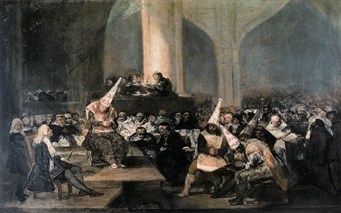The Spanish Inquisition
 The Spanish Inquisition was the judiciary ecclesiastical organization, aimed at combating heresies and against non-Catholic minorities, which functioned in Spain since the fifteenth century, under the direct control of the Spanish monarchs. It was established by a papal bull of Sixtus IV in 1478, and was a key instrument in the hands of Ferdinand of Aragon and Isabella of Castile to conclude the process of the Reconquista and to strike several groups of Jews and Muslims in the Iberian Peninsula. The expulsion of the first in 1492 and the restrictive measures with respect to the Moriscos (Muslim converts, often by force, to Christianity) were also the result of the robust action of the Inquisitor General, Tomás de Torquemada. Subsequently, the Inquisition pursued various groups considered heretics, as Erasmians, Lutheran, alumbrados, mystics, the “illuminated” and, in the American colonies, the native peoples suspected of idolatrous “superstition”. At the head of the Spanish Inquisition, there was the Consejo de la Suprema y General Inquisición, whose president was the General Inquisitor. The courts judged the accused, even if then it was the secular authorities which dealt with the execution of the sentence. The family members were instead those who, though lacking a fixed salary, played a key role, encouraging denunciations, collecting evidence and capturing the accused. They also enjoyed privileges such as tax exemption and the right to bear arms. The autos de fe were instead the ceremonies during which the prisoners suffered the punishment for their crime, which could range from public humiliation to burning at the stake. Temporarily abolished by the government of Napoleon, the Spanish Inquisition was finally dissolved in 1834.
The Spanish Inquisition was the judiciary ecclesiastical organization, aimed at combating heresies and against non-Catholic minorities, which functioned in Spain since the fifteenth century, under the direct control of the Spanish monarchs. It was established by a papal bull of Sixtus IV in 1478, and was a key instrument in the hands of Ferdinand of Aragon and Isabella of Castile to conclude the process of the Reconquista and to strike several groups of Jews and Muslims in the Iberian Peninsula. The expulsion of the first in 1492 and the restrictive measures with respect to the Moriscos (Muslim converts, often by force, to Christianity) were also the result of the robust action of the Inquisitor General, Tomás de Torquemada. Subsequently, the Inquisition pursued various groups considered heretics, as Erasmians, Lutheran, alumbrados, mystics, the “illuminated” and, in the American colonies, the native peoples suspected of idolatrous “superstition”. At the head of the Spanish Inquisition, there was the Consejo de la Suprema y General Inquisición, whose president was the General Inquisitor. The courts judged the accused, even if then it was the secular authorities which dealt with the execution of the sentence. The family members were instead those who, though lacking a fixed salary, played a key role, encouraging denunciations, collecting evidence and capturing the accused. They also enjoyed privileges such as tax exemption and the right to bear arms. The autos de fe were instead the ceremonies during which the prisoners suffered the punishment for their crime, which could range from public humiliation to burning at the stake. Temporarily abolished by the government of Napoleon, the Spanish Inquisition was finally dissolved in 1834.
Read more:
- H. Kamen, The Spanish Inquisition, London 1965.
- N. Roth, Conversos, Inquisition and the expulsion of the Jews from Spain, University of Wisconsin Press 1995.
- J. Martínez Millán, La Inquisición española, Madrid 2009.
